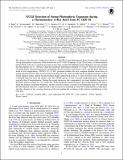| dc.contributor.author | Keek, L. | |
| dc.contributor.author | Arzoumanian, Z. | |
| dc.contributor.author | Chakrabarty, Deepto | |
| dc.contributor.author | Chenevez, J. | |
| dc.contributor.author | Gendreau, K. C. | |
| dc.contributor.author | Guillot, S. | |
| dc.contributor.author | Güver, T. | |
| dc.contributor.author | Homan, J. | |
| dc.contributor.author | Jaisawal, G. K. | |
| dc.contributor.author | LaMarr, Beverly J. | |
| dc.contributor.author | Lamb, F. K. | |
| dc.contributor.author | Mahmoodifar, S. | |
| dc.contributor.author | Markwardt, C. B. | |
| dc.contributor.author | Okajima, T. | |
| dc.contributor.author | Strohmayer, T. E. | |
| dc.contributor.author | in ’t Zand, J. J. M. | |
| dc.date.accessioned | 2020-04-17T18:51:10Z | |
| dc.date.available | 2020-04-17T18:51:10Z | |
| dc.date.issued | 2018-04 | |
| dc.date.submitted | 2018-03 | |
| dc.identifier.issn | 2041-8213 | |
| dc.identifier.issn | 2041-8205 | |
| dc.identifier.uri | https://hdl.handle.net/1721.1/124734 | |
| dc.description.abstract | The Neutron Star Interior Composition Explorer (NICER) on the International Space Station (ISS) observed strong photospheric expansion of the neutron star in 4U 1820-30 during a Type I X-ray burst. A thermonuclear helium flash in the star's envelope powered a burst that reached the Eddington limit. Radiation pressure pushed the photosphere out to ∼200 km, while the blackbody temperature dropped to 0.45 keV. Previous observations of similar bursts were performed with instruments that are sensitive only above 3 keV, and the burst signal was weak at low temperatures. NICER's 0.2-12 keV passband enables the first complete detailed observation of strong expansion bursts. The strong expansion lasted only 0.6 s, and was followed by moderate expansion with a 20 km apparent radius, before the photosphere finally settled back down at 3 s after the burst onset. In addition to thermal emission from the neutron star, the NICER spectra reveal a second component that is well fit by optically thick Comptonization. During the strong expansion, this component is six times brighter than prior to the burst, and it accounts for 71% of the flux. In the moderate expansion phase, the Comptonization flux drops, while the thermal component brightens, and the total flux remains constant at the Eddington limit. We speculate that the thermal emission is reprocessed in the accretion environment to form the Comptonization component, and that changes in the covering fraction of the star explain the evolution of the relative contributions to the total flux. ©2018 | en_US |
| dc.publisher | American Astronomical Society | en_US |
| dc.relation.isversionof | 10.3847/2041-8213/AAB904 | en_US |
| dc.rights | Article is made available in accordance with the publisher's policy and may be subject to US copyright law. Please refer to the publisher's site for terms of use. | en_US |
| dc.source | IOP Publishing | en_US |
| dc.title | NICER detection of strong photospheric expansion during a thermonuclear x-ray burst from 4U 1820-30 | en_US |
| dc.type | Article | en_US |
| dc.identifier.citation | Keek, L., et al., "NICER detection of strong photospheric expansion during a thermonuclear x-ray burst from 4U 1820-30." Astrophysical journal. Letters 856 (2018): letter 37 doi 10.3847/2041-8213/AAB904 ©2018 Author(s) | en_US |
| dc.contributor.department | Massachusetts Institute of Technology. Department of Physics | en_US |
| dc.contributor.department | MIT Kavli Institute for Astrophysics and Space Research | en_US |
| dc.relation.journal | Astrophysical journal. Letters | en_US |
| dc.eprint.version | Final published version | en_US |
| dc.type.uri | http://purl.org/eprint/type/JournalArticle | en_US |
| eprint.status | http://purl.org/eprint/status/PeerReviewed | en_US |
| dc.date.updated | 2018-08-24T14:08:00Z | |
| dspace.embargo.terms | N | en_US |
| dspace.date.submission | 2019-04-04T10:39:00Z | |
| mit.journal.volume | 856 | en_US |
| mit.license | PUBLISHER_POLICY | en_US |
| mit.metadata.status | Complete | |
